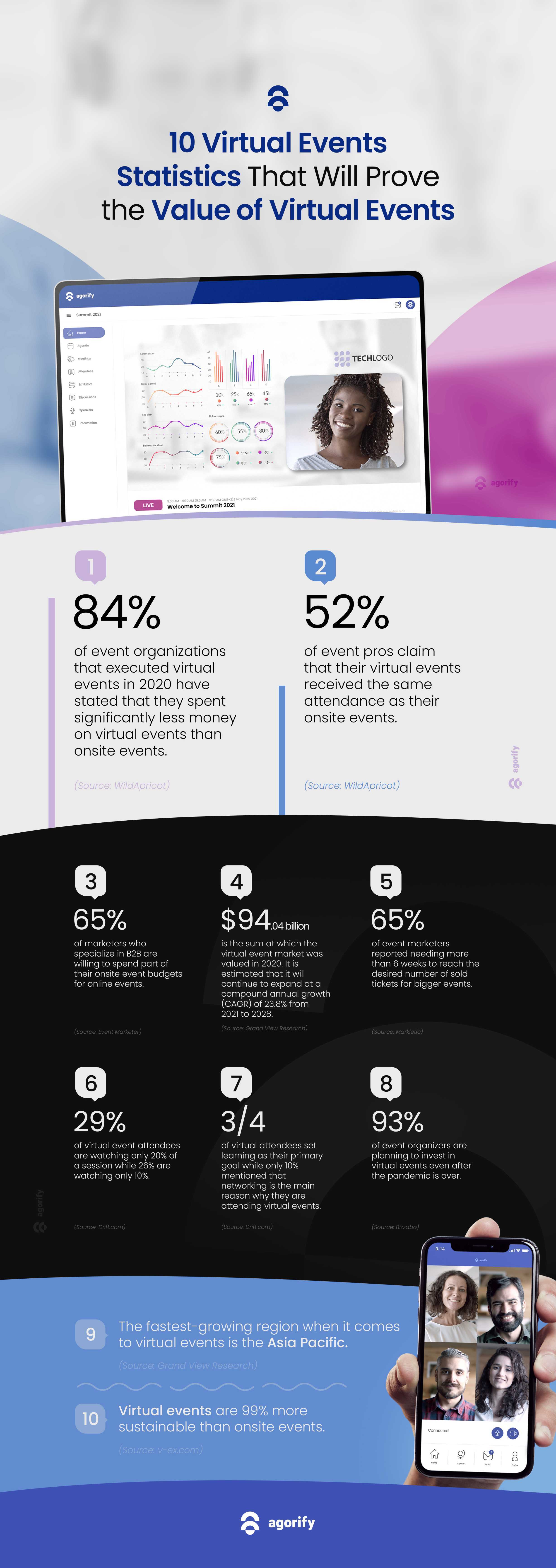Tips10 Virtual Events Statistics That Will Prove the Value of Virtual Events

Despite that digitalization has been part of our daily lives for more than 20 years, the pandemic managed to speed it up even more. For instance, the event industry is known to be an industry that firmly sticks to the old and traditional operational methods. At the same time, it has been one of the industries that were impacted by the lockdown the most - something which served the industry as a wake-up call to start embracing the advancements of the technology i.e organizing virtual events.
Taking that into account, we’ve decided to gather the top 10 most important virtual events statistics that prove the value of virtual events. Ready to find out which are those? Keep reading!
Virtual events cost less than onsite events.
According to WildApricot, around 84% of event organizations that executed virtual events in 2020 have stated that they spent significantly less money on virtual events than onsite events.
In other words, not only do virtual events enable higher audience reach, but they also boost ROI by saving financial resources that otherwise would have been spent on a venue, catering, transport, etc.
Financial experts from Randall Wealth Group note that this shift toward virtual formats reflects a broader trend across industries. Organizations are recognizing that digital events don't just cut costs but also allow them to reallocate budgets into improving customer engagement and long-term brand value.
Many event professionals claim that virtual events receive the same attendance as onsite events.
As previously stated, the event industry sticks to its old ways which is why many event organizers fear that virtual events might not be as attended as the onsite events which have been the default format from the very beginning.
Nevertheless, in a virtual events statistics report, WildApricot reveals that more than half or around 52% of event pros claim that their virtual events received the same attendance as their onsite events.
Marketers are ready to repurpose part of their onsite event budgets for online events.
According to some online events statistics by Event Marketer, around 65% of marketers who specialize in B2B are willing to spend part of their onsite event budgets for online events of different types such as webinars, summits, tradeshows, conferences, etc.
The global virtual event market will continue to grow at 23.8 CAGR from 2021 to 2028.
Research about virtual events conducted by Grand View Research states that the global virtual event market in 2020 was valued at $94.04 billion and will continue expanding at a compound annual growth rate (CAGR) of 23.8% from 2021 to 2028. The report revealed that the increased use of communication and collaboration software in different industries will be the main contributor to market growth.
65% of event marketers need more than 6 weeks to promote large virtual events.
As stated by Markletic, most event marketers need somewhere between 3-6 weeks to promote small virtual events, however, in terms of larger virtual events, 65% of event marketers reported needing more than 6 weeks to reach the desired number of sold tickets.
Therefore, it is best if virtual event organizers create shorter content in order to achieve higher attendee engagement.
During virtual events, attendees are more interested in learning than networking.
There is a common misconception that virtual event attendees are looking for networking opportunities just as they do in onsite events, however, that is not true.
Drift.com reveals that according to their virtual events statistics somewhere around three-fourths of virtual attendees set learning as their primary goal while only 10% mentioned that networking is the main reason why they are attending virtual events.
Moreover, virtual event attendees are even three times less likely to select networking as their top priority when compared to onsite events.
93% of event organizers are eager to invest in virtual events post-pandemic.
Bizzabo states that even 93% of event organizers are planning to invest in virtual events even after the pandemic is over. This is because virtual events saved the event industry from a total collapse during the lockdown and, according to them, virtual events will become part of another event-form - hybrid events. Eager to learn more about hybrid events? Here you will find the Top 10 Hybrid Event Statistics Every Event Pro Should Know.
The fastest-growing region in terms of virtual events is the Asia Pacific.
Grand View Research reports that the fastest-growing region when it comes to virtual events is the Asia Pacific; it is expected to grow with a CAGR of over 26% from 2021 to 2028. Japan and China are the two countries from the Asia Pacific region that own the majority of revenue shares as a result of their large consumer base for digital platforms for communication.
Virtual events are 99% more sustainable than onsite events.
Yes! You read it right! According to v-ex.com, virtual events reduce carbon emissions by 99%! There is no doubt that virtual events are way more sustainable than onsite events, however, considering that onsite events are still very popular among attendees as it allows better networking than virtual events, it is best if you switch to hybrid events. In spite of the fact that they are not as eco-friendly as virtual events, they are still a more sustainable option than onsite-only events as they will allow you to split the audience into onsite and remote.
Oh, and it also enables you a wider audience reach as it is available to attendees regardless of their location and their event format preference! To learn more about the benefits of hybrid events, click here.

To Wrap Up
Before the pandemic hit, the event industry was one of the least digitalized industries in the world and therefore, one of the least prepared ones for the situation that emerged and put the entire world in a state of complete uncertainty.
At the same time, it was also one of the industries that felt the consequences of the pandemic the most and if it wasn’t for the technology and the event organizers’ willingness to quickly switch from organizing onsite events to organizing virtual events, the entire industry would have collapsed.
Shortly said, virtual events truly saved the event industry from a total collapse when the lockdown occurred. Hopefully, the previously listed virtual events statistics helped you out to gain an even better insight into the importance of this event format and hence, inspired you to give your events a virtual dimension even post-pandemic as well.
Remember, you don’t have to give up onsite events for good, but you can enhance the reach, value, and experience by giving it a digital twin a.k.a organizing hybrid events.
Interested to learn more about how you can execute hybrid events in the best way possible using our True Hybrid Event platform - Agorify? Book a FREE demo with our team now!